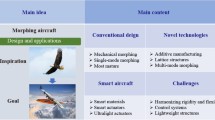Abstract
A review of recent shape memory alloy (SMA) aeronautical applications is highlighted. To date, SMAs have not been successfully employed in critical aircraft actuation due to several technological and infrastructure challenges. Albeit fully functional SMA prototypes were demonstrated in aerospace environments over a decade ago, other critical elements such as material form, certification, and other crucial design tools have not progressed with the same level of maturity. The applications presented here have acknowledged these shortcomings and are built on previous successes to thrust SMAs a step closer to aircraft adoption. The spanwise adaptive wing (SAW) project and the wind tunnel remote control actuation (RCA) are the new applications that employ new advancement. First, the SAW project is the first ever, fully integrated flight test employing high-temperature SMAs with flight-relevant properties. The project utilized NiTiHf alloys with suitable actuation temperatures, and scalable to commercially available lots/forms. Second, the RCA project represents the next paradigm shift in wind tunnel testing. This application employs NiTi torque tubes capable of moving and controlling the model parts, enabling increased productivity, improved data quality, and reduced cost of wind tunnel testing. An overview of each application is provided here, with insights into system-level successes, challenges, and lessons learned.












Similar content being viewed by others
References
https://www.marketsandmarkets.com/PressReleases/shape-memory-alloy.asp. Accessed Nov 2019
Wayman CM, Harrison JD (1989) The origins of the shape memory effect. JOM 41(9):26–28
Benafan O et al (2017) On the processability and scale-up of NiTi-20Hf high temperature shape memory alloys. In: The international conference on shape memory and superelastic technologies (SMST 2017), San Diego, CA, May 2017
ASTM E3097–17 (2017) Standard test method for mechanical uniaxial constant force thermal cycling of shape memory alloys. ASTM International, West Conshohocken, PA, 2017. www.astm.org
ASTM E3098–17 (2017) Standard test method for mechanical uniaxial pre-strain and thermal free recovery of shape memory alloys. ASTM International, West Conshohocken, PA, 2017. www.astm.org
Hartl DJ et al (2015) Standardization of shape memory alloy test methods toward certification of aerospace applications. Smart Mater Struct 24(8):082001
Benafan O et al (2018) Shape memory materials database: a compilation of shape memory properties. In: The ASME 2018 conference on smart materials, adaptive structures and intelligent systems (SMASIS) , San Antonio, TX, September 10–12, 2018
Benafan O, Moholt MR (2019) Spanwise adaptive wing: an overview and challenges of in-flight wing folding using shape memory alloys. In: Conference proceedings of the international conference on shape memory and superelastic technologies (SMST), Konstanz, Germany, May 13–17, 2019
Bass M et al (2019) Spanwise adaptive wing: coupled shape memory alloy tubes for high torque applications. In: Conference proceedings of the international conference on shape memory and superelastic technologies (SMST), Konstanz, Germany, May 13–17, 2019
Bass M et al (2019) Spanwise adaptive wing: shape memory alloy actuation systems for in-flight wing folding. In: Conference proceedings of the international conference on shape memory and superelastic technologies (SMST), Konstanz, Germany, May 13–17, 2019
Nicholson DE et al (2019) Shape memory alloy enabled remote control actuated high speed cryogenic wind tunnel models. In: Conference proceedings of the international conference on shape memory and superelastic technologies (SMST), Konstanz, Germany, May 13–17, 2019
Benafan O et al (2018) Spanwise adaptive wing: shape memory alloy high torque actuator mechanisms. In: The ASME 2018 conference on smart materials, adaptive structures and intelligent systems (SMASIS), San Antonio, TX , September 10–12, 2018
Moholt M, Benafan O (2017) Overview of the spanwise adaptive wing NASA technical report sever, Doc. ID#20170009544
Moholt M, Benafan O (2018) Overview of the spanwise adaptive wing project. In: AIAA aviation forum, flight testing conference, Atlanta, GA, June 2018
Calkins FT et al (2019) Low & high speed cryogenic testing of a wind tunnel model with remote control actuation (RCA) spoiler. In: AIAA Aviation 2019 Forum, Dallas, Texas, p 2975
Dussart GX et al (2019) In-flight folding wingtip system: inspiration from the XB-70 Valkyrie. In: AIAA Scitech 2019 Forum
NASA Facts (2019) Remotely piloted PTERA bridges gap between wind-tunnel and crewed flight testing, FS-2015–10–108 AFRC. https://www.nasa.gov/sites/default/files/atoms/files/fs-108-afrc.pdf. Accessed Nov 2019
Benafan O, Gaydosh DJ (2019) Scale-up of NiTiHf shape memory alloy tubes with high torque capability. Smart Mater Struct 28(8):085035
Benafan O, Gaydosh DJ (2018) Constant-torque thermal cycling and two-way shape memory effect in Ni50.3Ti29.7Hf20 torque tubes. Smart Mater Struct 27(7):075035
Acknowledgements
Spanwise Adaptive Wing Funding from the NASA Aeronautics Research Mission Directorate (ARMD) Convergent Aeronautics Solutions (CAS) project is gratefully acknowledged. The authors thank the entire SAW team from NASA GRC, NASA AFRC, NASA LaRC, the Boeing Company, and AREA-I for their valuable contributions. Remote Control Actuation (RCA) The authors gratefully acknowledge the cooperation and collaboration from a large group of interested parties from Boeing, NASA, outstanding German suppliers & contributors such as Deharde and ETW—friends and colleagues all—and finally the U.S. and German governments.
Author information
Authors and Affiliations
Corresponding author
Additional information
Publisher's Note
Springer Nature remains neutral with regard to jurisdictional claims in published maps and institutional affiliations.
Rights and permissions
About this article
Cite this article
Benafan, O., Moholt, M.R., Bass, M. et al. Recent Advancements in Rotary Shape Memory Alloy Actuators for Aeronautics. Shap. Mem. Superelasticity 5, 415–428 (2019). https://doi.org/10.1007/s40830-019-00260-3
Published:
Issue Date:
DOI: https://doi.org/10.1007/s40830-019-00260-3




